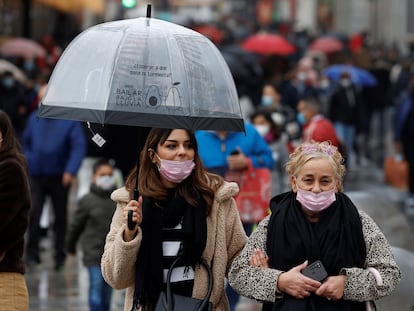A third of 40-49 age group in Spain have received Covid-19 booster shots
The vaccination campaign has reached 38% of the entire population, which is in line with the EU average but below leading countries such as Denmark, Italy and France
The Covid-19 vaccination campaign continues to move at a steady speed in Spain during this latest phase, which is focusing on booster shots for adults and first doses for the under-12s. The regions, which are in charge of managing the process, have been administering more than a million shots a week, reaching 1.6 million in the last seven days.
Meanwhile, nine out of 10 citizens aged over 70 have had a third dose of a vaccine, while for the 60-69 group the figure is 84%. More than half of the 50-59 group has also had a booster shot, as have more than a third of those aged 40-49. Among children aged between five and 11, 44% have had a first dose of the pediatric vaccine so far.
For the population of Spain as a whole, 38% have had a booster shot. This is in line with the average across the European Union, but considerably lower than countries such as Denmark (56%), Italy (45%) and France (41%). This is in contrast to Spain’s ranking for the initial vaccination campaign, where the country is not just one of the leaders in the EU, but also across the world.
The difference can be explained due to the strategy adopted by the Spanish government: while many other countries opted to offer a third dose to the general public months ago, Spain has taken an approach based on age. Until mid-December, the under-60s were not eligible for the booster shot unless they were healthcare staff or people with chronic illness.
The rhythm in Spain during this new part of the campaign is slower than that of other phases, which saw as many as four million shots administered a week. But as explained by José Antonio Forcada, the president of the National Association of Nursing and Vaccines (Anenvac), “there is less urgency.” Progress is conditioned on a five-month period elapsing between having received the initial doses (until last week the protocol actually stated six months), and on infections, which are currently being registered in Spain in their hundreds of thousands a week and are delaying the booster shot for those who get infected.
The important thing is for the percentage of booster shots among older people to be very highManuel Franco, spokesperson for the Spanish Public Health Society (Sespas)
Forcada adds that the most important thing is for seniors and people with pre-existing conditions to get their shots, given that they are the most vulnerable to Covid-19. “It’s important to complete the booster shots for these people, who have a greater risk of ending up in hospital compared to young and healthy people,” he explains. “In the rest of the groups, there is not the same haste. What’s more, staff are tired, there are many people off sick, and it wouldn’t be possible to return to the rhythm of past months.”
Manuel Franco, the spokesperson for the Spanish Public Health Society (Sespas), agrees. “The important thing is for the percentage of booster shots among older people to be very high,” he says, adding that territorial differences also need to be addressed. Right now, 94% of the over-70s in Asturias and Galicia have received booster shots, while in the Canary and Balearic islands, the figure is 10 points lower. “There is no reason for such a contrast,” he argues. “There are places where the campaign is going very well, and public health consists of looking at these and learning from them.”
Last week, the Health Ministry and the regions began to pave the way for the booster shots to be made available to everyone over the age of 18. While the vaccination campaign is moving forward for all ages, the focus right now is on the 40-49 age group, who are mostly arriving at the six-month mark since their second shot last summer. Last week, more than 614,000 people in this group got their third injection in Spain. In the coming weeks, it will be the turn of the 20-29 and 30-29 groups, who have shown to be the most reluctant to get vaccinated (85% compared to the average of 90.5% in the over-12s).
Franco believes that, as happened with the original shots, as the campaign moves down the age groups, a lower percentage of the population will opt to get a booster. Partly this is because they are less vulnerable to serious illness from Covid-19 and partly because they feel protected with two doses. While it is true that the individual risk of serious illness is very small after having received two doses of the vaccine, for the entire population and in absolute terms, thousands of hospitalizations could be avoided, according to medical studies.
Underreporting of cases
“What’s more, the idea is spreading among the population that the third dose affects you considerably for a few days due to the expected side effects, such as fever,” Franco explains. “This doesn’t help people to get it, because not everyone can spend two days lying down.”
What’s more, an ever-greater percentage of people are getting Covid-19 after having been fully vaccinated – the underreporting of cases is making it difficult to know exactly how many. While the vaccine greatly reduces the risk of serious illness and death, its effects are lesser in terms of avoiding contagion, and it is still unknown how much it slows the spread of the highly contagious omicron variant.
The Health Ministry and the regions established a gap of at least four weeks between an infection and the booster shot, but a number of immunologists and virologists consulted by EL PAÍS believe that it is not necessary so soon after. “After vaccination, an omicron infection is like a new dose, but more complete, because not only does it expose us to a part of the virus, as with the injection, but also to all of its antigens,” explains Marcos López Hoyos, president of the Spanish Immunology Society. “By injecting dose after dose ad infinitum without spacing them out we are not going to achieve better protection,” he adds.
Incidence rises a further 205 points
Yesterday the Spanish Health Ministry reported 331,467 new coronavirus infections since Friday, adding 234 fatalities to the official death toll from the pandemic. The cumulative incidence rose another 205 points, to 3,397 cases per 100,000 inhabitants in the last 14 days.
The regions with the highest incidence are currently Navarre (cumulative incidence of 6,056 cases), the Basque Country (5,981 cases) and Aragón (5,962). In total, 8,424,503 official infections have been detected since the pandemic reached Spain, while 90,993 people have died after testing postive.
The Health Ministry also reported that between 73% and 97% of detected infections between January 3 and 9 were the more-contagious omicron variant, according to random PCR analysis in 14 of Spain’s 17 regions.
The occupation of hospital beds by Covid-19 patients has reached the “very high risk” level, with 15% of beds occupied by coronavirus cases compared to 14% on Friday. In total, there are 18,821 people hospitalized, 2,251 of them in intensive care units (ICUs). This is an increase of 1,385 patients over the weekend, according to the report.
Catalonia continues to be the region with the highest pressure on its ICUs, with an occupation level of 44%, followed by Aragón (32%) and the Basque Country (31%).
Tu suscripción se está usando en otro dispositivo
¿Quieres añadir otro usuario a tu suscripción?
Si continúas leyendo en este dispositivo, no se podrá leer en el otro.
FlechaTu suscripción se está usando en otro dispositivo y solo puedes acceder a EL PAÍS desde un dispositivo a la vez.
Si quieres compartir tu cuenta, cambia tu suscripción a la modalidad Premium, así podrás añadir otro usuario. Cada uno accederá con su propia cuenta de email, lo que os permitirá personalizar vuestra experiencia en EL PAÍS.
¿Tienes una suscripción de empresa? Accede aquí para contratar más cuentas.
En el caso de no saber quién está usando tu cuenta, te recomendamos cambiar tu contraseña aquí.
Si decides continuar compartiendo tu cuenta, este mensaje se mostrará en tu dispositivo y en el de la otra persona que está usando tu cuenta de forma indefinida, afectando a tu experiencia de lectura. Puedes consultar aquí los términos y condiciones de la suscripción digital.
More information
Últimas noticias
Most viewed
- Reinhard Genzel, Nobel laureate in physics: ‘One-minute videos will never give you the truth’
- Oona Chaplin: ‘I told James Cameron that I was living in a treehouse and starting a permaculture project with a friend’
- Pablo Escobar’s hippos: A serious environmental problem, 40 years on
- Chevy Chase, the beloved comedian who was a monster off camera: ‘Not everyone hated him, just the people who’ve worked with him’
- Why we lost the habit of sleeping in two segments and how that changed our sense of time











































